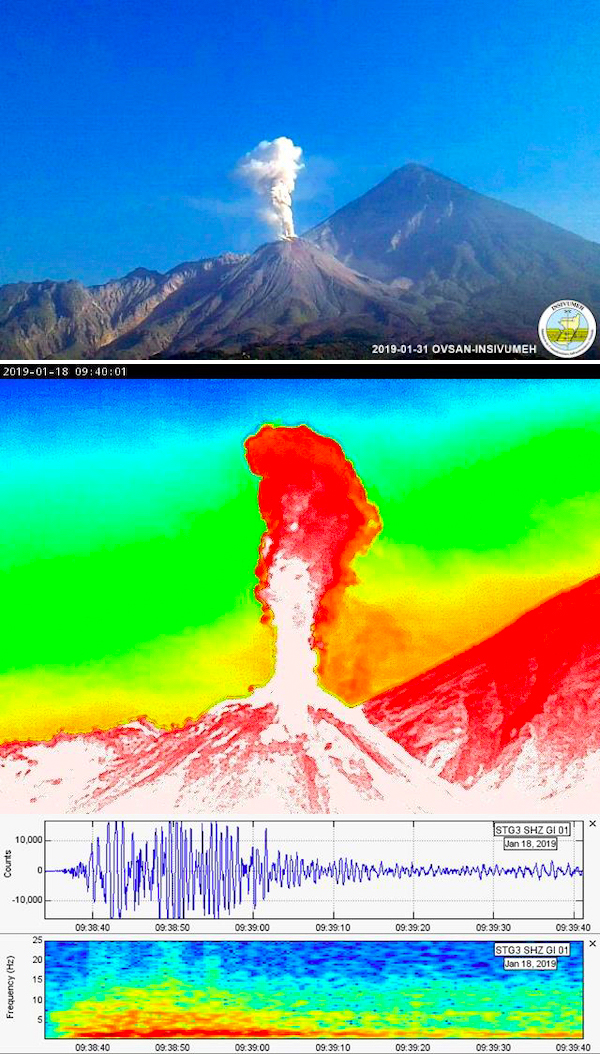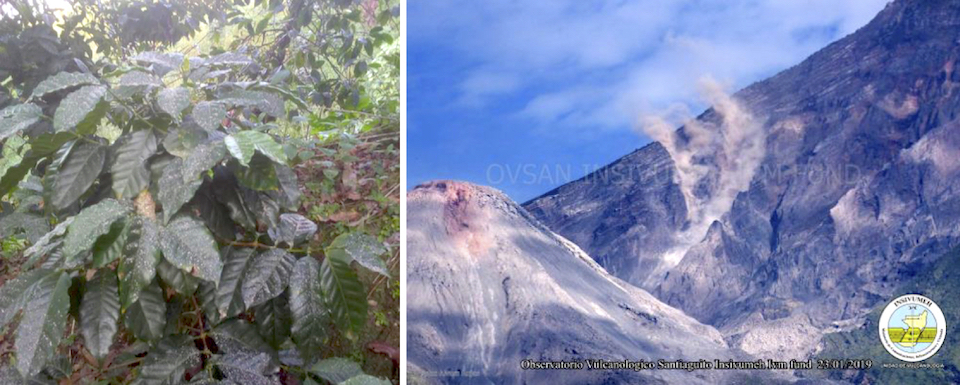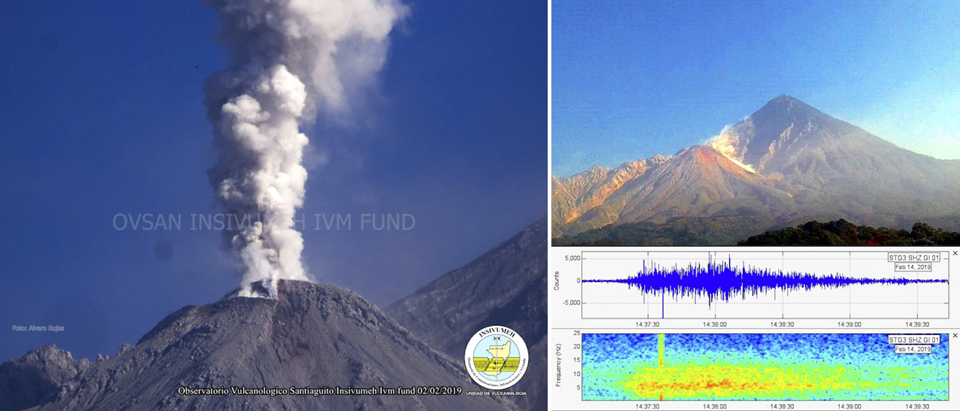Report on Santa Maria (Guatemala) — March 2019
Bulletin of the Global Volcanism Network, vol. 44, no. 3 (March 2019)
Managing Editor: Edward Venzke.
Edited by A. Elizabeth Crafford.
Santa Maria (Guatemala) Daily explosions cause steam-and-ash plumes and block avalanches, November 2018-February 2019
Please cite this report as:
Global Volcanism Program, 2019. Report on Santa Maria (Guatemala) (Crafford, A.E., and Venzke, E., eds.). Bulletin of the Global Volcanism Network, 44:3. Smithsonian Institution. https://doi.org/10.5479/si.GVP.BGVN201903-342030
Santa Maria
Guatemala
14.757°N, 91.552°W; summit elev. 3745 m
All times are local (unless otherwise noted)
The dacitic Santiaguito lava-dome complex on the W flank of Guatemala's Santa María volcano has been growing and actively erupting since 1922. The youngest of the four vents in the complex, Caliente, has been erupting with ash explosions, pyroclastic, and lava flows for more than 40 years. A lava dome that appeared within the summit crater of Caliente in October 2016 has continued to grow, producing frequent block avalanches down the flanks. Daily explosions of steam and ash also continued during November 2018-February 2019, the period covered in this report, with information primarily from Guatemala's INSIVUMEH (Instituto Nacional de Sismologia, Vulcanologia, Meterologia e Hidrologia) and the Washington VAAC (Volcanic Ash Advisory Center).
Activity at Santa Maria continued with little variation from previous months during November 2018-February 2019. Plumes of steam with minor magmatic gases rose continuously from the Caliente crater 100-500 m above the summit, generally drifting SW or SE before dissipating. In addition, daily explosions with varying amounts of ash rose to altitudes of around 2.8-3.5 km and usually extended 20-30 km before dissipating. Most of the plumes drifted SW or SE; minor ashfall occurred in the adjacent hills almost daily and was reported at the fincas located within 15 km in those directions several times each month. Continued growth of the Caliente lava dome resulted in daily block avalanches descending its flanks. The MIROVA plot of thermal energy during this time shows a consistent level of heat flow with minor variations throughout the period (figure 89).
During November 2018 steam plumes rose to altitudes of 2.8-3.2 km from Caliente summit, usually drifting SW, sometimes SE. Several ash-bearing explosions were reported daily, rising to 3-3.2 km altitude and also drifting SW or SE. The highest plume reported by INSIVUMEH rose to 3.4 km on 25 November and drifted SW. The Washington VAAC reported an ash emission on 9 November that rose to 4.3 km altitude and drifted W; it dissipated within a few hours about 35 km from the summit. On 11 November another plume rose to 4.9 km altitude and drifted NW. INSIVUMEH issued a special report on 2 November noting an increase in block avalanches on the S and SE flanks, many of which traveled from the crater dome to the base of the volcano. Nearly constant avalanche blocks descended the SE flank of the dome and occasionally traveled down the other flanks as well throughout the month. They reached the bottom of the cone again on 29 November. Ashfall was reported around the flanks more than once every week and at Finca Florida on 12 November. Finca San Jose reported ashfall on 11, 13, and 23 November, and Parcelamiento Monte Claro reported ashfall on 15, 24, 25, and 27 November.
Constant degassing from the Caliente dome during December 2018 formed white plumes of mostly steam that rose to 2.6-3.0 km altitude during the month. Weak explosions averaging 9-13 per day produced gray ash plumes that rose to 2.8-3.4 km altitude. The Washington VAAC reported an ash emission on 4 December that extended 25 km SW of the summit at 3.0 km altitude and dissipated quickly. Small ash plumes were visible in satellite imagery a few kilometers WNW on 8, 12, 30, and 31 December at 4.3 km altitude; they each dissipated within a few hours. Ashfall was reported in Finca Monte Claro on 1 and 4 December, and in San Marcos Palajunoj on 26 and 30 December along with Loma Linda. On 28 December ashfall on the E flank affected the communities of Las Marías, Calahuache, and El Nuevo Palmar. Block avalanches occurred daily, sending large blocks to the base of the volcano that often stirred up small plumes of ash in the vicinity (figure 90).
Multiple explosions daily during January 2019 produced steam-and-ash plumes (figure 91). Constant degassing rising 10-500 m emerged from the SSE part of the Caliente dome, and ashfall, mainly on the W and SW rim of the cone, was a daily feature. Seismic station STG-3 detected 10-18 explosions per day that produced ash plumes, which rose to between 2.7 and 3.5 km altitude. The Washington VAAC noted a faint ash emission in satellite imagery on 1 January that was about 25 km W of the summit at 4.3 km altitude. A new emission appeared at the same altitude on 4 January about 15 km NW of the summit. A low-density emission around midday on 5 January produced an ash plume that drifted NNE at 4.6 km altitude. Ash plumes drifted W at 4.3 km altitude on 11 and 14 January for short periods of time before dissipating.
Ash drifted mainly towards the W, SW, and S, causing ashfall in the villages of San Marcos Palajunoj, Loma Linda, Monte Bello, El Patrocinio, La Florida, El Faro, Patzulín and a few others several times during the month. The main places where daily ashfall was reported were near the complex, in the hilly crop areas of the El Faro and San José Patzulín farms (figure 92). Blocks up to 3 m in diameter reached the base of the complex, stirring up ash plumes that settled on the immediate flanks. Juvenile material continued to appear at the summit of the dome during January; the dome had risen above the edge of the crater created by the explosions of 2016. Changes in the size and shape of the dome between 23 November 2018 and 13 January 2019 showed the addition of material on the E and SE side of the dome, as well as a new effusive flow that travelled 200-300 m down the E flank (figure 93).
Persistent steam rising 50-150 m above the crater was typical during February 2019 and accompanied weak and moderate explosions that averaged 12 per day throughout the month. White and gray ash plumes from the explosions rose to 2.8-3.3 km altitude; daily block avalanches usually reached the base of the dome (figure 94). Ashfall occurred around the complex, mainly on the W, SW, and NE flanks on a daily basis, but communities farther away were affected as well. The Washington VAAC reported an ash plume on 7 February in visible satellite imagery moving SW from the summit at 4.9 km altitude. The next day a new ash plume was located about 20 km W of the summit, dissipating rapidly, at 4.3 km altitude. Ashfall drifting SW affected Palajuno Monte Claro on 5, 9, 15, and 16 February. Ash drifting E and SE affected Calaguache, Las Marías and surrounding farms on 14 and 17 February, and fine-grained ash drifting SE was reported at finca San José on 21 February.
Geological Summary. Symmetrical, forest-covered Santa María volcano is part of a chain of large stratovolcanoes that rise above the Pacific coastal plain of Guatemala. The sharp-topped, conical profile is cut on the SW flank by a 1.5-km-wide crater. The oval-shaped crater extends from just below the summit to the lower flank, and was formed during a catastrophic eruption in 1902. The renowned Plinian eruption of 1902 that devastated much of SW Guatemala followed a long repose period after construction of the large basaltic-andesite stratovolcano. The massive dacitic Santiaguito lava-dome complex has been growing at the base of the 1902 crater since 1922. Compound dome growth at Santiaguito has occurred episodically from four vents, with activity progressing E towards the most recent, Caliente. Dome growth has been accompanied by almost continuous minor explosions, with periodic lava extrusion, larger explosions, pyroclastic flows, and lahars.
Information Contacts: Instituto Nacional de Sismologia, Vulcanologia, Meteorologia e Hydrologia (INSIVUMEH), Unit of Volcanology, Geologic Department of Investigation and Services, 7a Av. 14-57, Zona 13, Guatemala City, Guatemala (URL: http://www.insivumeh.gob.gt/); Washington Volcanic Ash Advisory Center (VAAC), Satellite Analysis Branch (SAB), NOAA/NESDIS OSPO, NOAA Science Center Room 401, 5200 Auth Rd, Camp Springs, MD 20746, USA (URL: www.ospo.noaa.gov/Products/atmosphere/vaac, archive at: http://www.ssd.noaa.gov/VAAC/archive.html); MIROVA (Middle InfraRed Observation of Volcanic Activity), a collaborative project between the Universities of Turin and Florence (Italy) supported by the Centre for Volcanic Risk of the Italian Civil Protection Department (URL: http://www.mirovaweb.it/).







